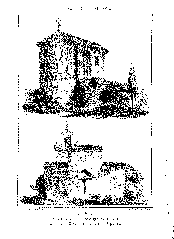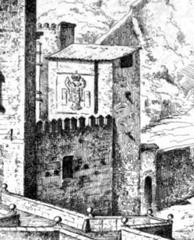Visiting Castillo de Almonacid: History, Tickets, and Tips
Date: 24/07/2024
Introduction
Nestled atop a hill in Toledo, Spain, the Castillo de Almonacid de Toledo is a historical gem that offers visitors a rich tapestry of history and breathtaking views. This fortress, originally constructed by the Moors in the 9th century, has witnessed numerous pivotal events in Spanish history. From its strategic role during the Moorish period to its significance in the Napoleonic Wars, the castle stands as a testament to the region’s tumultuous past and diverse cultural influences. Visitors today can explore the ruins, delve into the castle’s storied past, and enjoy panoramic vistas of the surrounding countryside. This comprehensive guide aims to provide all the essential information you need for an unforgettable visit, including historical insights, visitor tips, and details on nearby attractions. Whether you’re a history enthusiast, an architecture aficionado, or simply in search of beauty and inspiration, the Castillo de Almonacid de Toledo promises a journey back in time. (source, source, source)
Table of Contents
- Introduction
- Historical Background
- Visitor Information
- Nearby Attractions
- Special Events and Guided Tours
- Architectural Features
- Preservation Efforts
- Visitor Experience
- Frequently Asked Questions (FAQ)
- Conclusion
Historical Background
Origins and Early History
The origins of Castillo de Almonacid de Toledo trace back to the 9th century, specifically to the year 848, when it was first mentioned in historical records. The castle was built by the Moors and served as a strategic point of vigilance over an ancient road to La Mancha (source). Its initial purpose was to monitor and control the movement along this crucial route, which was vital for trade and military operations.
The Moorish Period
During the Moorish period, the castle was known as “ribat,” a term that means monastery in Arabic. This indicates that the castle may have had a dual function, serving both as a military fortification and a religious site (source). The name “Almonacid” is believed to be derived from the Latin word “almonaster,” meaning monastery, further supporting this dual-purpose theory.
Transition to Christian Rule
In the 11th century, the castle came into the possession of King Alfonso VI of Castile as part of the dowry of his wife, Princess Zaida, the daughter of a Moorish king (source). This transition marked the beginning of the castle’s integration into the Christian kingdom of Castile. In 1086, Alfonso VI donated the castle to the archbishopric of Toledo, signifying its importance in the region’s ecclesiastical and military hierarchy.
Architectural Evolution
The castle underwent significant modifications in the 14th century under the direction of Archbishop Don Pedro Tenorio. These renovations included strengthening the fortifications and adding new defensive structures (source). The castle’s architecture reflects a blend of Moorish, Gothic, and Renaissance elements, showcasing the diverse influences that have shaped the region over the centuries (source).
Role in the Napoleonic Wars
One of the most notable events in the castle’s history occurred during the Napoleonic Wars. On August 11, 1809, the castle served as a refuge for Spanish troops under General Venegas during a battle against French forces commanded by General Sebastiani (source). The battle, known as the Battle of Almonacid, ended in a French victory, with significant casualties on both sides—4,000 Spanish and 2,000 French soldiers (source). This battle is commemorated on the Arc de Triomphe in Paris, highlighting its historical significance.
Decline and Ruin
In the 19th century, the castle began to fall into disrepair. In 1839, the mayor of Almonacid allowed the villagers to use the castle’s materials for private purposes, accelerating its decline (source). Despite its ruined state, the castle remains a significant historical monument, offering a glimpse into the region’s tumultuous past.
Visitor Information
Visiting Hours and Tickets
Castillo de Almonacid de Toledo is freely accessible to the public. However, it’s advisable to check the local municipality’s website or contact them for up-to-date information on visiting hours and any potential entrance fees (source).
How to Get There
The castle is located in the province of Toledo, Spain. Visitors can reach the site by car or public transportation. Detailed directions and transportation options can be found on travel websites or local guides.
Nearby Attractions
While visiting Castillo de Almonacid de Toledo, consider exploring other historical sites in the region, such as the Toledo Cathedral, Alcázar of Toledo, and the Monastery of San Juan de los Reyes. Each of these sites offers a unique glimpse into the rich history of Toledo.
Special Events and Guided Tours
The castle hosts various cultural events, exhibitions, and educational programs throughout the year. Guided tours are available to provide in-depth historical insights and enhance your visitor experience. Check the local municipality’s website for the latest information on events and tours.
Architectural Features
The castle’s architecture is a testament to the various cultural and historical influences that have shaped it over the centuries. The robust fortifications, intricate stonework, and commanding towers reflect the artistic and architectural prowess of its builders (source). The castle’s design not only served practical defensive purposes but also symbolizes the region’s rich cultural heritage.
Preservation Efforts
Efforts to preserve and restore the castle have been ongoing. In the 16th century, architect Don Pedro Gumiel noted the need for urgent repairs, highlighting the castle’s deteriorating condition even then (source). Today, the local municipality continues to work on preserving this historical monument, ensuring that future generations can appreciate its historical and cultural significance.
Visitor Experience
Visitors to Castillo de Almonacid de Toledo can explore its ancient corridors, admire the architectural details, and soak in the stunning views of the surrounding countryside. The castle offers a journey back in time, providing an opportunity to connect with the rich tapestry of Spanish history (source). Whether you’re a history enthusiast, an architecture aficionado, or simply someone in search of beauty and inspiration, the castle promises an unforgettable experience.
Frequently Asked Questions (FAQ)
What are the visiting hours for Castillo de Almonacid de Toledo?
The castle is generally open to the public, but it’s advisable to check the local municipality’s website for the most current visiting hours.
Are there guided tours available at Castillo de Almonacid de Toledo?
Yes, guided tours are available and offer in-depth historical insights. Check the local municipality’s website for more details.
How much are tickets for Castillo de Almonacid de Toledo?
The castle is currently freely accessible, but it’s best to verify any potential entrance fees on the local municipality’s website.
What are some nearby attractions to Castillo de Almonacid de Toledo?
Nearby attractions include the Toledo Cathedral, Alcázar of Toledo, and the Monastery of San Juan de los Reyes.
Conclusion
The Castillo de Almonacid de Toledo stands as a remarkable testament to the rich historical and cultural heritage of Toledo, Spain. From its origins as a Moorish fortification to its role in the Napoleonic Wars, the castle has played a significant part in shaping the region’s history. Despite its current state of ruin, efforts to preserve and restore the castle underscore its enduring importance. Visitors exploring the ancient corridors and admiring the architectural details can connect deeply with the past, gaining insights into the diverse cultural influences that have shaped this iconic site. Whether you’re visiting for its historical significance, architectural marvels, or stunning views, the Castillo de Almonacid de Toledo offers an unforgettable experience. By following the visitor tips and practical information provided, you can ensure a safe and enriching visit. Don’t forget to explore nearby attractions and enjoy the local cuisine to complete your journey through Toledo’s rich heritage. For more updates and detailed guides on historical sites, download our mobile app Audiala and follow us on social media. (source, source, source)















